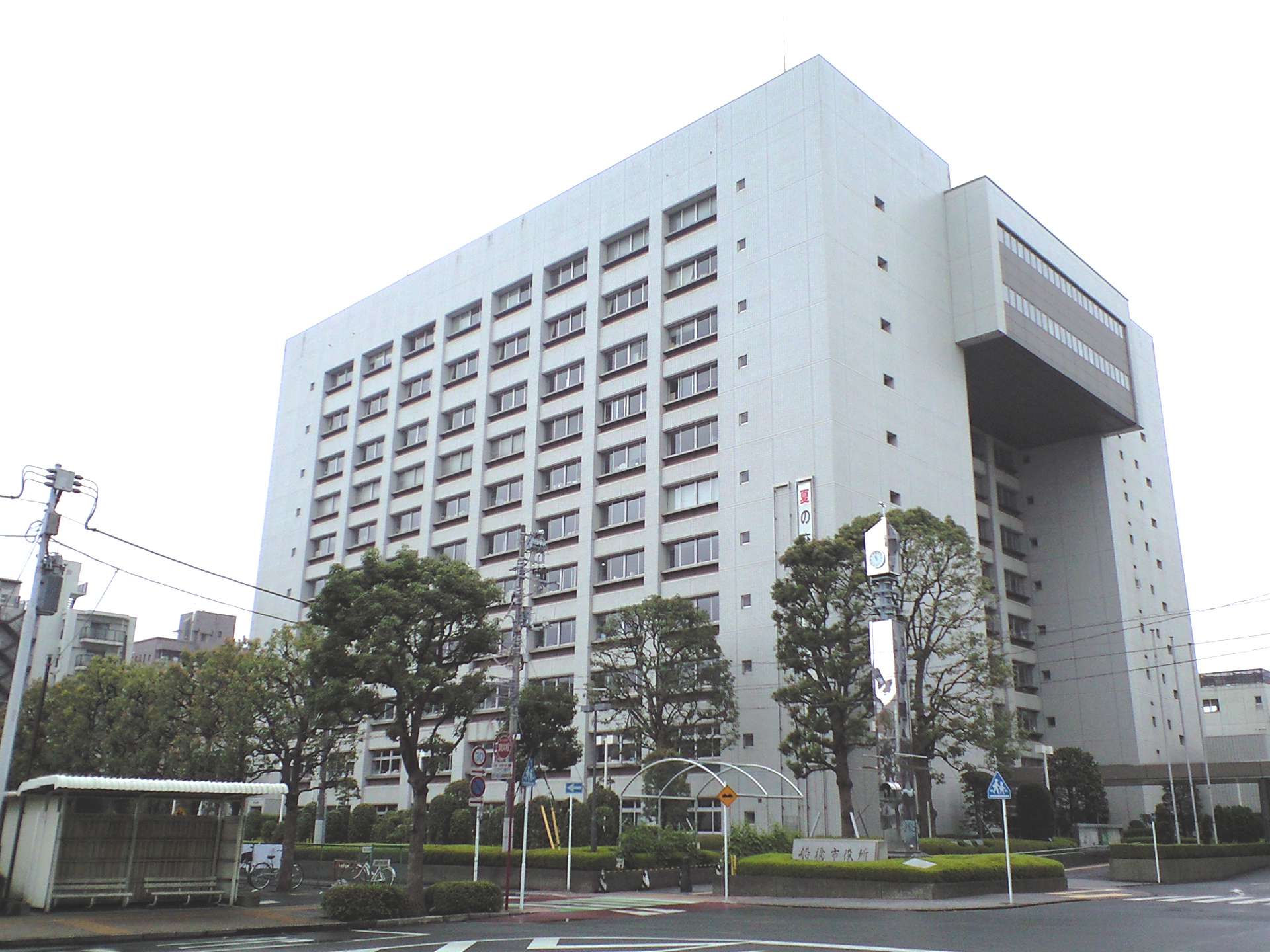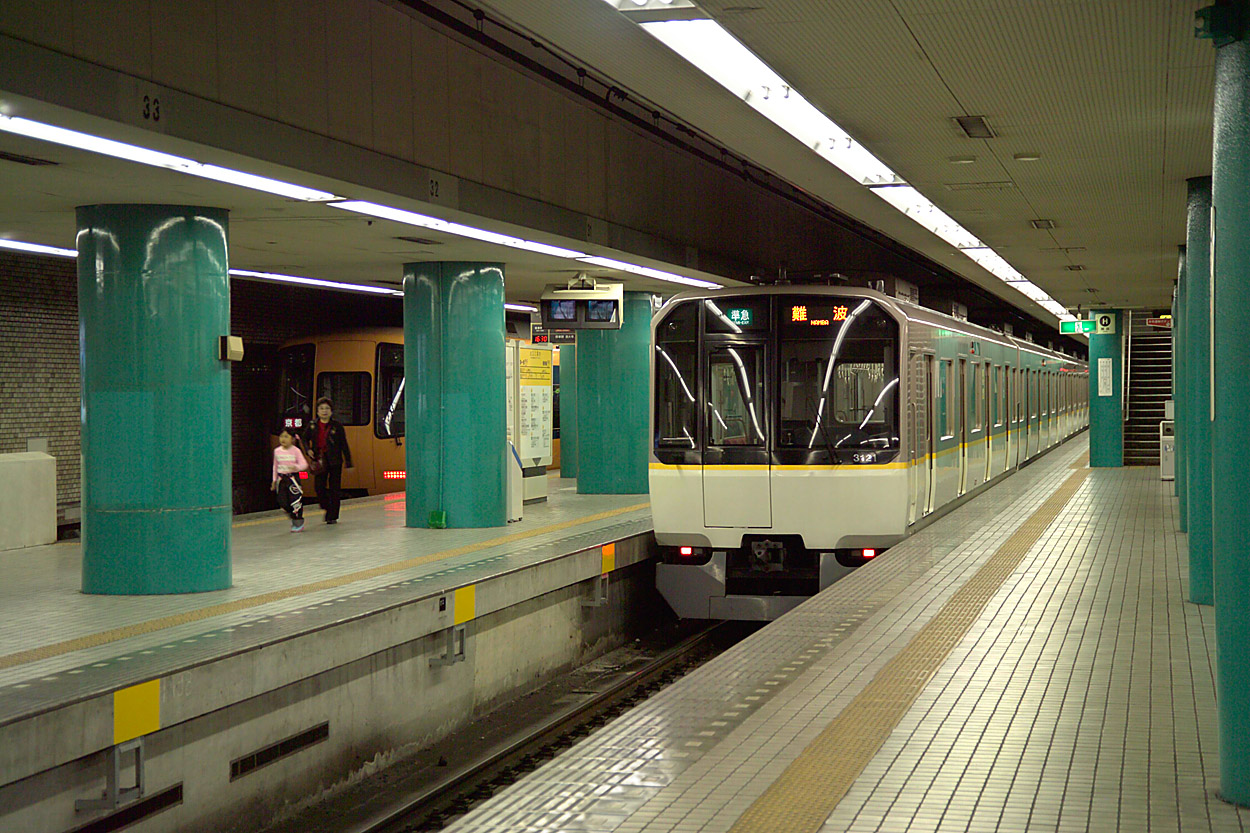|
Nishi-Funabashi Station
is a railway station in Funabashi, Japan, operated by East Japan Railway Company (JR East), Tokyo Metro, and the Tōyō Rapid Railway. It is the easternmost station of the Tokyo subway network, lying in Chiba Prefecture. Lines Nishi-Funabashi Station is served by the following lines. *East Japan Railway Company **Chūō-Sōbu Line **Musashino Line **Keiyō Line *Tokyo Metro **Tokyo Metro Tōzai Line, Tōzai Line *Tōyō Rapid Railway **Tōyō Rapid Railway Line Station layout The station consists of six island platforms serving eleven tracks on two levels (another two tracks are used by Sōbu Line (Rapid) trains which do not stop at the station). The high-level station serves the Keiyō Line, Keiyō and Musashino Lines. The low level is served by the Chūō-Sōbu Line, Sōbu, Tokyo Metro Tōzai Line, Tōzai and Tōyō Rapid Railway Lines. The low level can be subdivided into two sections, one served by trains running into Tokyo via the Sōbu Line and the other by trains runnin ... [...More Info...] [...Related Items...] OR: [Wikipedia] [Google] [Baidu] |
Funabashi
is a city located in Chiba Prefecture, Japan. , the city had an estimated population of 644,668 in 309,238 households and a population density of . The total area of the city is . It is the Greater Tokyo Area's 7th most populated city (after passing Kawaguchi, Hachioji and Chiba), and second largest in Chiba Prefecture. Geography Funabashi is located in northwestern Chiba Prefecture approximately 20 kilometers in either direction from the prefectural capital at Chiba and downtown Tokyo. The central area forms a flat diluvial upland of the Shimōsa Plateau. The city sits at an elevation of 20 to 30 meters above sea level, and is relatively flat. The highest point is 32.3 meters in Narashino 3-chome, and the lowest point is 0.2 meters in Minatomachi 1-chome. Funabashi is crossed by the Tone River, and the small Ebi River is located entirely within city limits. Funabashi formerly had wide, shallow beaches, but much of the coast has been industrialized and transformed by recla ... [...More Info...] [...Related Items...] OR: [Wikipedia] [Google] [Baidu] |
Matsumoto Bus Terminal
Matsumoto Bus Terminal (松本バスターミナル, ''Matsumoto Basu Tāminaru'') is a bus terminal to the east of Matsumoto Station in Matsumoto, Nagano, Japan, managed by Alpico Kōtsū. Outline This bus terminal is on the ground floor of "Matsuden Bus Terminal Building""Matsuden" is abbreviation of Matsumoto Dentetsu which Alpico Kotsu owns and manages. "ALPICO PLAZA" is also on the building. Lines Commuter Lines *Track 1 **Shindai-Yokota Cycle Line **Asama Line *Track 2 **Yokota-Shindai Cycle Line **Shin-Asama Line *Track 3 **Utsukushigahara-Spa Line **Iriyamabe Line **Shiga Line **Alps-Park Line *Track 4 **Kotobukidai Line **Uchida Line **Namiyanagi Danchi Line *Track 5 **Airport-Asahi Line **Kambayashi-Mizushiro Line **Yamagata Line **Kakeyu-Spa LinePassengers are able to transfer onto Chikuma Bus bound for Ueda Station (Nagano) at Kakeyu Onsen bus stop. (Runs on weekdays) **Misayama Line **Nakayama Line Highway Lines *Track 6 ** Chuo Highway Bus Matsumoto Line; For S ... [...More Info...] [...Related Items...] OR: [Wikipedia] [Google] [Baidu] |
Chūgū-ji
is a temple in Nara Prefecture, Japan, that was founded as a nunnery in the seventh century by Shōtoku Taishi. Located immediately to the northeast of Hōryū-ji, its statue of Miroku and Tenjukoku mandala are National Treasures. History Chūgūji was once the palace of Hashihito, mother of Shōtoku Taishi. After her death it was converted into a temple. It was restored and converted to a nunnery by the nun Shinnyo in the late Kamakura period. Originally standing three hundred metres to the east, it was moved to its present location in the Muromachi period. Chūgū-ji is one of three nunneries in Yamato whose chief priestesses were imperial princesses. The site of Chūgū-ji has been designated a Historic Site, and the Edo period Omotegomon has been registered as a cultural property. Miroku Bosatsu The camphor wood statue of is a National Treasure dating from the Asuka period. Formerly painted, it is finished in lacquer. Tenjukoku Shūchō Mandala After the death of Shō ... [...More Info...] [...Related Items...] OR: [Wikipedia] [Google] [Baidu] |
Kintetsu-Kōriyama Station
is a railway station on Kintetsu Kashihara Line in Yamatokōriyama, Nara, Japan. Lines * Kintetsu Railway ** Kashihara Line The is a north-south bound railway line in Nara Prefecture, Japan, owned and operated by the Kintetsu Railway, a private railway operator. It connects Yamato-Saidaiji Station and Kashiharajingu-mae Station. Service outline Most Express and Li ... Platforms and tracks The station has two side platforms serving one track each. History The station opened in 1921 on the Unebi Line of Osaka Electric Tramway, a predecessor of the Kintetsu Railway. Surrounding * Kōriyama Castle External links * * Railway stations in Japan opened in 1921 Railway stations in Nara Prefecture {{Nara-railstation-stub ... [...More Info...] [...Related Items...] OR: [Wikipedia] [Google] [Baidu] |
Nara Station
is a railway station located in Nara, Japan. Operated by West Japan Railway Company (JR West), it is the main stop in the city of Nara on the Kansai Main Line (Yamatoji Line), the terminus for the Sakurai Line (Man-yō Mahoroba Line), and Nara Line trains for begin here and run on the Kansai Line to before diverging. Also, a limited number of Gakkentoshi Line trains terminate here via Kizu during early mornings and late nights. Yamatoji Line trains from and continue past here to . Overview It is the central station of JR in the city of Nara, with many trains departing for Kyoto and Tennoji. Layout This station has three elevated island platforms serving five tracks. Platforms Passenger statistics According to the "Statistical Yearbook of Nara Prefecture", the average number of passengers per day is as follows. Adjacent stations , - !colspan=5, JR West Bus terminals highway buses * ''Yamato''; For Shinjuku Station and Keio Plaza Hotel * ''Yama ... [...More Info...] [...Related Items...] OR: [Wikipedia] [Google] [Baidu] |
Kintetsu Nara Station
is a railway station on the Nara Line in Nara, Japan, operated by the private railway operator Kintetsu Railway. Lines The station is the terminal station on the Nara Line. Kintetsu operates through expresses and limited expresses from Kyoto Station and Ōsaka Namba Station in Osaka. Passengers taking non through trains from Kyoto on the Kyoto Line have to change trains at Yamato-Saidaiji Station to get to Kintetsu Nara. Station layout The station consists of four platforms with four tracks on the second basement level. Platforms Adjacent stations History The station opened on 30 April 1914, initially named . It was renamed in August 1928, on 15 March 1941, and on 1 June 1944, before becoming Kintetsu Nara Station on 1 March 1970. Passenger statistics In 2010, the station was used by an average of 67,761 passengers daily. Surrounding area The station is located next to Kōfuku-ji and Nara Park; it is also possible to walk to the UNESCO World Heritage Sites ... [...More Info...] [...Related Items...] OR: [Wikipedia] [Google] [Baidu] |
Tenri Station
is a train station in Tenri, Nara, Japan. Although the station is on the Sakurai Line as rail infrastructure, it has been served by the Man-yō Mahoroba Line since 2010 in terms of passenger train services. Tenri Station is also served by the Tenri Line of the Kintetsu Railway. Lines * JR-West ** Man-yō Mahoroba Line * Kintetsu Railway ** Tenri Line Layout The station has two levels. The first level is used for the Tenri Line while the second level is used for the Man-yō Mahoroba Line. JR West platforms The station operated by JR West has 4 tracks with 2 island platforms. Kintetsu Railway platforms The station operated by Kintetsu Railway has 3 tracks with 2 island platforms and 2 side platforms (3 bay platforms). Since it is the terminal, there is no specification to which track is used for which service and destination. The stationmaster administrates all stations on the Tenri Line and the Kashihara Line between and as well as Tenri Station. Connections W ... [...More Info...] [...Related Items...] OR: [Wikipedia] [Google] [Baidu] |
Nagoya Station
is a major railway station in Nakamura-ku, Nagoya, Japan. It is one of the world's largest train stations by floor area (410,000 m2), and houses the headquarters of the Central Japan Railway Company (JR Central). Much of this space is located in the JR Central Towers atop the station, as well as in underground concourses. The current station complex was completed on December 20, 1999. The station and the area around it is officially called in the Japanese addressing system. The station is adjacent to Meitetsu Nagoya Station, the terminal of Meitetsu, and Kintetsu Nagoya Station, the terminal of the Kintetsu Nagoya Line. The twin-towered station rises over 50 storeys, and is the tallest railway-station building in the world. Lines JR Central * (for Shin-Yokohama, Tokyo, Kyoto, and Shin-Osaka) * (for , Ōgaki, Maibara, Obu, Kariya, Okazaki, Gamagori, Toyohashi, and Hamamatsu) * (for Kozoji, Tajimi, and Nakatsugawa) * (for Yokkaichi, Tsu, and Kameyama) Aonami Line *Aonami Line ... [...More Info...] [...Related Items...] OR: [Wikipedia] [Google] [Baidu] |
Sakae Station (Nagoya)
is an underground metro station located in Naka-ku, Nagoya, Aichi Prefecture, Japan operated by the Nagoya Municipal Subway. It is an interchange station between the Higashiyama Line and the Meijō Line and is located 9.0 rail kilometers from the terminus of the Higashiyama Line at Takabata Station and 3.0 rail kilometers from the terminus of the Meijō Line at Kanayama Station. This station is located in part of the upper class district of Nagoya. History Sakae Station was opened on 15 November 1957 as as a terminal station on the No. 1 Line, later renamed the Higashiyama Line. The new subway system replaced the electric tram which had run above ground. The No. 2 Line (later named the Meijō Line) connected to the station on 15 October 1965. The station was renamed to its present name on 1 June 1966. Lines * ** (Station number: H10) ** (Station number: M05) Layout Sakae Station has one underground island platform for use by the Higashiyama Line and two underground opposed ... [...More Info...] [...Related Items...] OR: [Wikipedia] [Google] [Baidu] |
Chikusa Station
is an interchange railway station in Higashi-ku and Chikusa-ku, Nagoya, Aichi Prefecture, Japan, operated by Central Japan Railway Company (JR Tōkai) and the Transportation Bureau City of Nagoya. Lines The above-ground portion off Chikusa Station is served by the Chūō Main Line, and is located 389.8 kilometers from the starting point of the line at Tokyo Station and 7.1 kilometers from Nagoya Station. the underground portion of the station is served by the Higashiyama Line of the Nagoya Municipal Subway and is 11.0 kilometers from the starting point of that line at Takabata Station. Layout The JR station has one elevated island platform with the station building underneath. The station building has automated ticket machines, TOICA automated turnstiles and a staffed ticket office. The underground portion the station has two opposed side platforms. The station building has automated ticket machines, Manaca automated turnstiles and a staffed ticket office. Platforms (JR Ce ... [...More Info...] [...Related Items...] OR: [Wikipedia] [Google] [Baidu] |
Motoyama Station (Nagoya)
is a railway station in Chikusa-ku, Nagoya, Aichi Prefecture, Japan It was opened on . The station provides access to Tōgan-ji which includes the Nagoya Daibutsu, Nagoya's large statue of Buddha. The area near this station also includes the Nagoya-area weather station A weather station is a facility, either on land or sea, with instruments and equipment for measuring atmospheric conditions to provide information for weather forecasts and to study the weather and climate. The measurements taken include tempera .... Lines * ** (Station number: H16) ** (Station number: M17) Layout Platforms References External links * Chikusa-ku, Nagoya Railway stations in Japan opened in 1963 Railway stations in Aichi Prefecture {{Aichi-railstation-stub ... [...More Info...] [...Related Items...] OR: [Wikipedia] [Google] [Baidu] |
Hoshigaoka Station (Nagoya)
is an underground metro station located in Chikusa-ku, Nagoya, Aichi Prefecture, Japan operated by the Nagoya Municipal Subway's Higashiyama Line. It is located 16.2 rail kilometers from the terminus of the Higashiyama Line at Takabata Station. This station provides access to Sugiyama Jogakuen University. History Hoshigaoka Station was opened on 30 March 1967. Lines * ** (Station number: H18) Layout Hoshigaoka Station Platforms Surrounding area *Higashiyama Zoo and Botanical Gardens ( 東山動植物園) * Sugiyama Jogakuen University ( 椙山女学園大学) *Hoshigaoka Mitsukoshi is an international department store chain with headquarters in Tokyo, Japan. It is a subsidiary of Isetan Mitsukoshi Holdings, which also owns the Isetan department store chain. History It was founded in 1673 with the (shop name) , selli ... (星ヶ丘 三越) References External links Hoshigaoka Station official web site Chikusa-ku, Nagoya Railway stations in ... [...More Info...] [...Related Items...] OR: [Wikipedia] [Google] [Baidu] |


_(2).jpg)
